Review of Fall Prevention Strategies in Hospitals: An Annotated Biblio
VerifiedAdded on 2023/04/24
|9
|2304
|253
Annotated Bibliography
AI Summary
This annotated bibliography examines various strategies for preventing falls and related injuries in hospital settings, a significant concern for patient safety. It reviews studies focusing on interventions such as staff education programs, team training, and the 6-PACK technique, analyzing their effectiveness in reducing fall rates. The bibliography includes summaries and critical appraisals of research articles, highlighting study designs, sample sizes, key findings, and limitations. The reviewed studies suggest that implementing multifaceted approaches can effectively minimize falls and improve patient outcomes in hospital environments. Access more solved assignments and study tools on Desklib.
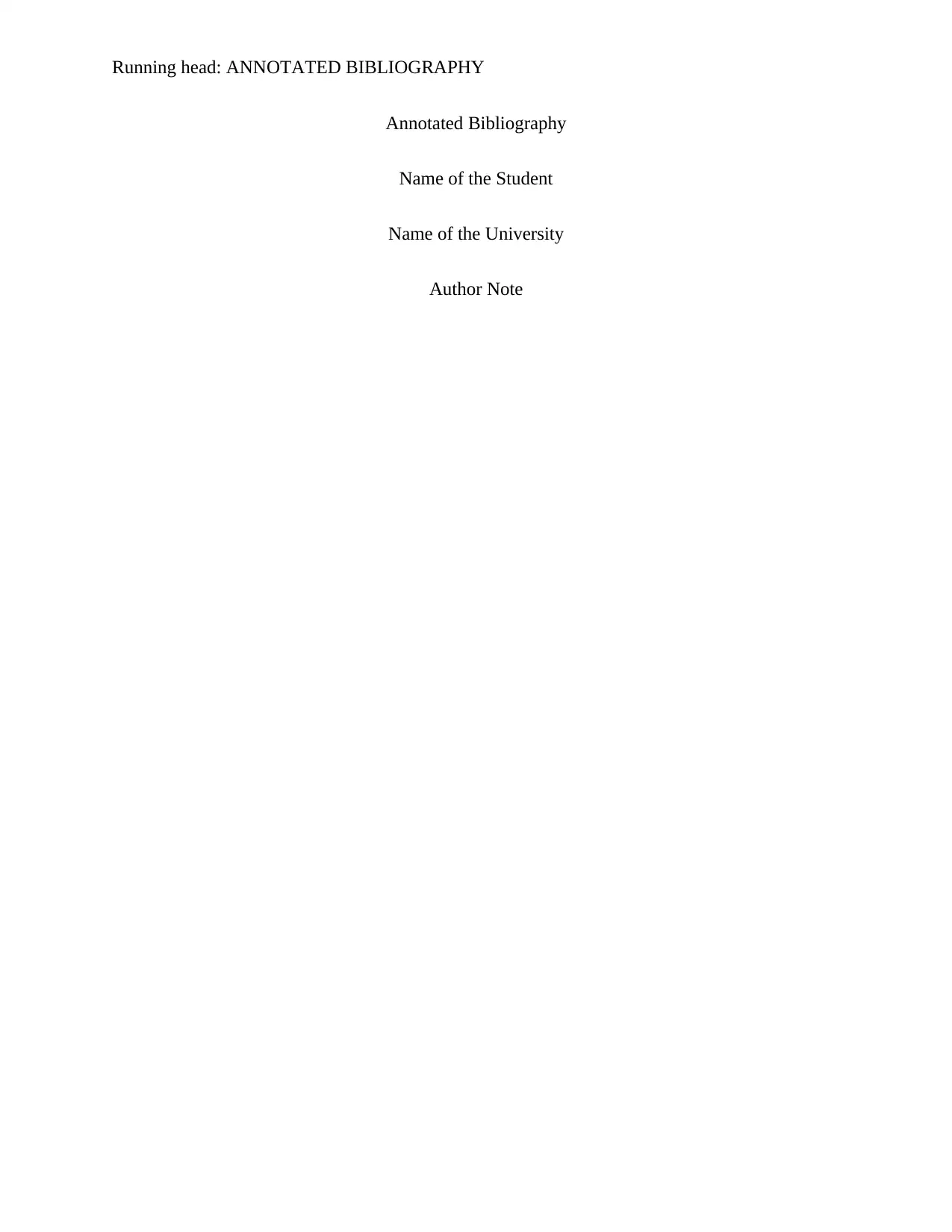
Running head: ANNOTATED BIBLIOGRAPHY
Annotated Bibliography
Name of the Student
Name of the University
Author Note
Annotated Bibliography
Name of the Student
Name of the University
Author Note
Paraphrase This Document
Need a fresh take? Get an instant paraphrase of this document with our AI Paraphraser
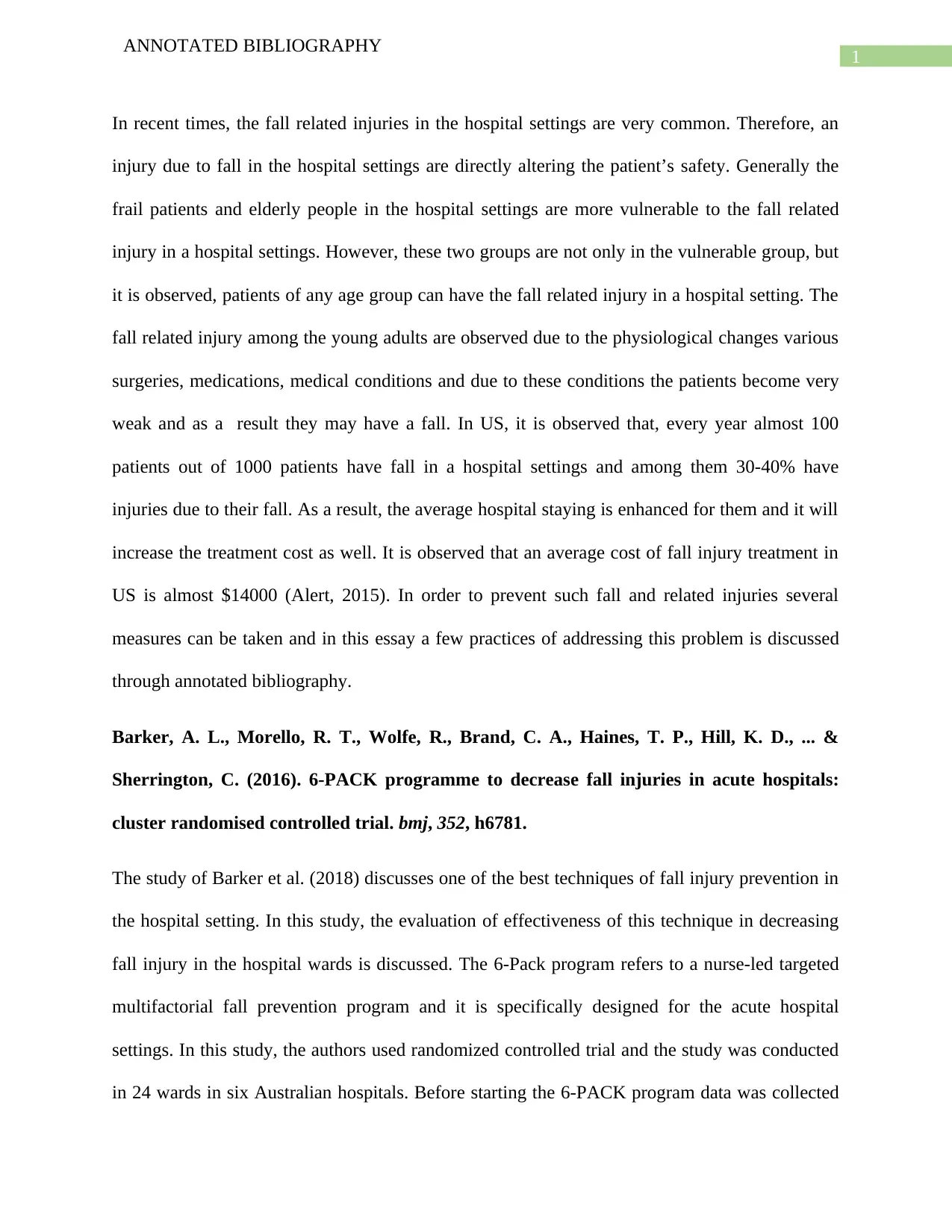
1
ANNOTATED BIBLIOGRAPHY
In recent times, the fall related injuries in the hospital settings are very common. Therefore, an
injury due to fall in the hospital settings are directly altering the patient’s safety. Generally the
frail patients and elderly people in the hospital settings are more vulnerable to the fall related
injury in a hospital settings. However, these two groups are not only in the vulnerable group, but
it is observed, patients of any age group can have the fall related injury in a hospital setting. The
fall related injury among the young adults are observed due to the physiological changes various
surgeries, medications, medical conditions and due to these conditions the patients become very
weak and as a result they may have a fall. In US, it is observed that, every year almost 100
patients out of 1000 patients have fall in a hospital settings and among them 30-40% have
injuries due to their fall. As a result, the average hospital staying is enhanced for them and it will
increase the treatment cost as well. It is observed that an average cost of fall injury treatment in
US is almost $14000 (Alert, 2015). In order to prevent such fall and related injuries several
measures can be taken and in this essay a few practices of addressing this problem is discussed
through annotated bibliography.
Barker, A. L., Morello, R. T., Wolfe, R., Brand, C. A., Haines, T. P., Hill, K. D., ... &
Sherrington, C. (2016). 6-PACK programme to decrease fall injuries in acute hospitals:
cluster randomised controlled trial. bmj, 352, h6781.
The study of Barker et al. (2018) discusses one of the best techniques of fall injury prevention in
the hospital setting. In this study, the evaluation of effectiveness of this technique in decreasing
fall injury in the hospital wards is discussed. The 6-Pack program refers to a nurse-led targeted
multifactorial fall prevention program and it is specifically designed for the acute hospital
settings. In this study, the authors used randomized controlled trial and the study was conducted
in 24 wards in six Australian hospitals. Before starting the 6-PACK program data was collected
ANNOTATED BIBLIOGRAPHY
In recent times, the fall related injuries in the hospital settings are very common. Therefore, an
injury due to fall in the hospital settings are directly altering the patient’s safety. Generally the
frail patients and elderly people in the hospital settings are more vulnerable to the fall related
injury in a hospital settings. However, these two groups are not only in the vulnerable group, but
it is observed, patients of any age group can have the fall related injury in a hospital setting. The
fall related injury among the young adults are observed due to the physiological changes various
surgeries, medications, medical conditions and due to these conditions the patients become very
weak and as a result they may have a fall. In US, it is observed that, every year almost 100
patients out of 1000 patients have fall in a hospital settings and among them 30-40% have
injuries due to their fall. As a result, the average hospital staying is enhanced for them and it will
increase the treatment cost as well. It is observed that an average cost of fall injury treatment in
US is almost $14000 (Alert, 2015). In order to prevent such fall and related injuries several
measures can be taken and in this essay a few practices of addressing this problem is discussed
through annotated bibliography.
Barker, A. L., Morello, R. T., Wolfe, R., Brand, C. A., Haines, T. P., Hill, K. D., ... &
Sherrington, C. (2016). 6-PACK programme to decrease fall injuries in acute hospitals:
cluster randomised controlled trial. bmj, 352, h6781.
The study of Barker et al. (2018) discusses one of the best techniques of fall injury prevention in
the hospital setting. In this study, the evaluation of effectiveness of this technique in decreasing
fall injury in the hospital wards is discussed. The 6-Pack program refers to a nurse-led targeted
multifactorial fall prevention program and it is specifically designed for the acute hospital
settings. In this study, the authors used randomized controlled trial and the study was conducted
in 24 wards in six Australian hospitals. Before starting the 6-PACK program data was collected
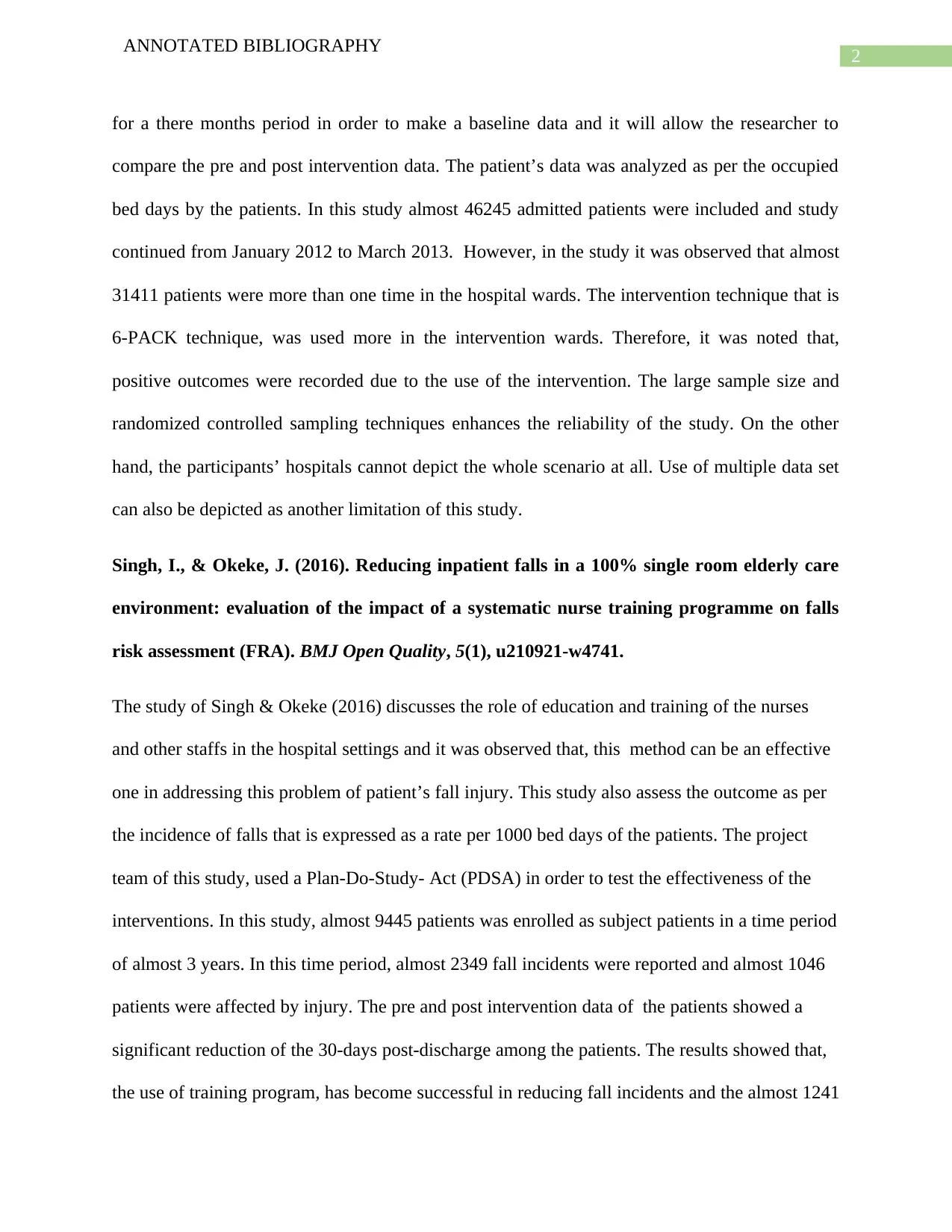
2
ANNOTATED BIBLIOGRAPHY
for a there months period in order to make a baseline data and it will allow the researcher to
compare the pre and post intervention data. The patient’s data was analyzed as per the occupied
bed days by the patients. In this study almost 46245 admitted patients were included and study
continued from January 2012 to March 2013. However, in the study it was observed that almost
31411 patients were more than one time in the hospital wards. The intervention technique that is
6-PACK technique, was used more in the intervention wards. Therefore, it was noted that,
positive outcomes were recorded due to the use of the intervention. The large sample size and
randomized controlled sampling techniques enhances the reliability of the study. On the other
hand, the participants’ hospitals cannot depict the whole scenario at all. Use of multiple data set
can also be depicted as another limitation of this study.
Singh, I., & Okeke, J. (2016). Reducing inpatient falls in a 100% single room elderly care
environment: evaluation of the impact of a systematic nurse training programme on falls
risk assessment (FRA). BMJ Open Quality, 5(1), u210921-w4741.
The study of Singh & Okeke (2016) discusses the role of education and training of the nurses
and other staffs in the hospital settings and it was observed that, this method can be an effective
one in addressing this problem of patient’s fall injury. This study also assess the outcome as per
the incidence of falls that is expressed as a rate per 1000 bed days of the patients. The project
team of this study, used a Plan-Do-Study- Act (PDSA) in order to test the effectiveness of the
interventions. In this study, almost 9445 patients was enrolled as subject patients in a time period
of almost 3 years. In this time period, almost 2349 fall incidents were reported and almost 1046
patients were affected by injury. The pre and post intervention data of the patients showed a
significant reduction of the 30-days post-discharge among the patients. The results showed that,
the use of training program, has become successful in reducing fall incidents and the almost 1241
ANNOTATED BIBLIOGRAPHY
for a there months period in order to make a baseline data and it will allow the researcher to
compare the pre and post intervention data. The patient’s data was analyzed as per the occupied
bed days by the patients. In this study almost 46245 admitted patients were included and study
continued from January 2012 to March 2013. However, in the study it was observed that almost
31411 patients were more than one time in the hospital wards. The intervention technique that is
6-PACK technique, was used more in the intervention wards. Therefore, it was noted that,
positive outcomes were recorded due to the use of the intervention. The large sample size and
randomized controlled sampling techniques enhances the reliability of the study. On the other
hand, the participants’ hospitals cannot depict the whole scenario at all. Use of multiple data set
can also be depicted as another limitation of this study.
Singh, I., & Okeke, J. (2016). Reducing inpatient falls in a 100% single room elderly care
environment: evaluation of the impact of a systematic nurse training programme on falls
risk assessment (FRA). BMJ Open Quality, 5(1), u210921-w4741.
The study of Singh & Okeke (2016) discusses the role of education and training of the nurses
and other staffs in the hospital settings and it was observed that, this method can be an effective
one in addressing this problem of patient’s fall injury. This study also assess the outcome as per
the incidence of falls that is expressed as a rate per 1000 bed days of the patients. The project
team of this study, used a Plan-Do-Study- Act (PDSA) in order to test the effectiveness of the
interventions. In this study, almost 9445 patients was enrolled as subject patients in a time period
of almost 3 years. In this time period, almost 2349 fall incidents were reported and almost 1046
patients were affected by injury. The pre and post intervention data of the patients showed a
significant reduction of the 30-days post-discharge among the patients. The results showed that,
the use of training program, has become successful in reducing fall incidents and the almost 1241
⊘ This is a preview!⊘
Do you want full access?
Subscribe today to unlock all pages.

Trusted by 1+ million students worldwide
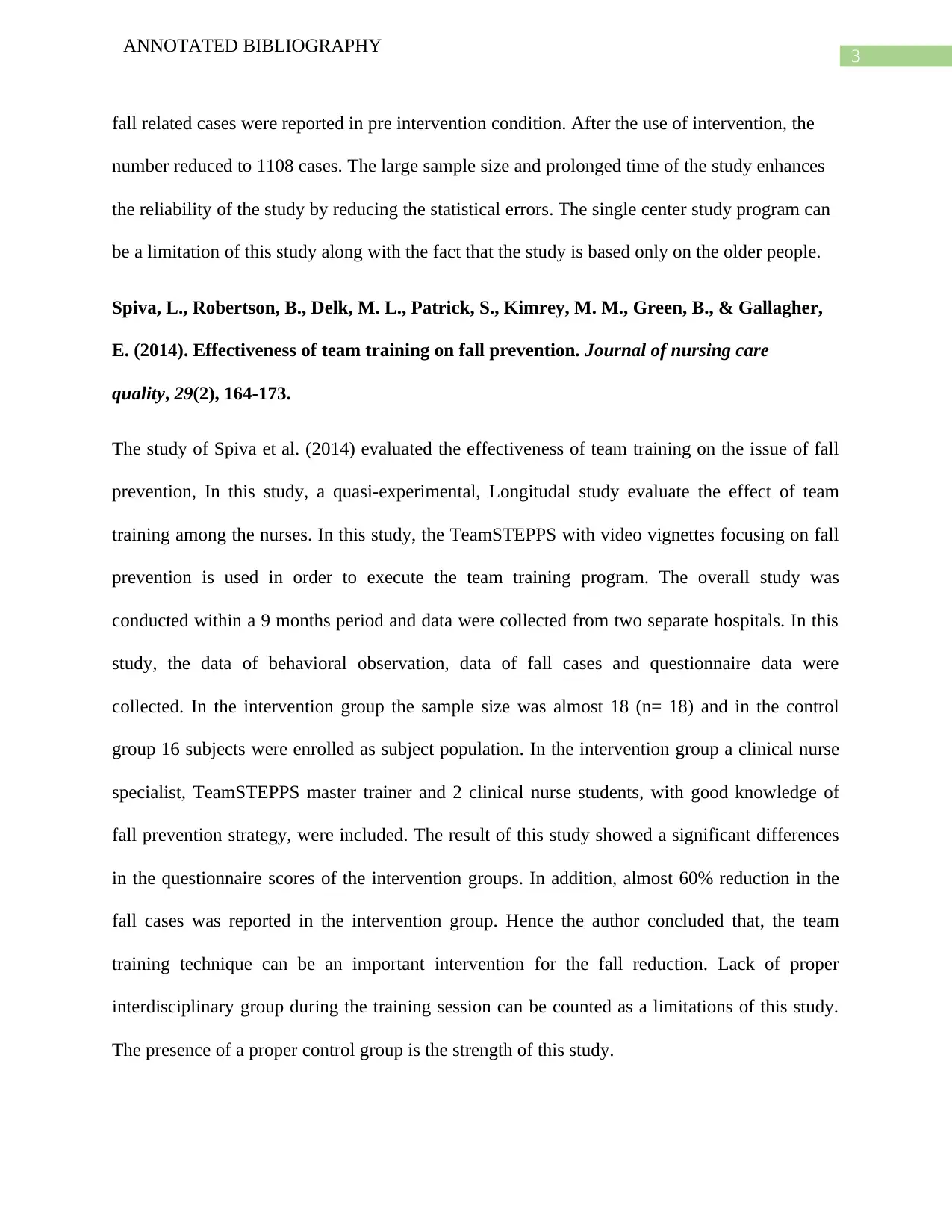
3
ANNOTATED BIBLIOGRAPHY
fall related cases were reported in pre intervention condition. After the use of intervention, the
number reduced to 1108 cases. The large sample size and prolonged time of the study enhances
the reliability of the study by reducing the statistical errors. The single center study program can
be a limitation of this study along with the fact that the study is based only on the older people.
Spiva, L., Robertson, B., Delk, M. L., Patrick, S., Kimrey, M. M., Green, B., & Gallagher,
E. (2014). Effectiveness of team training on fall prevention. Journal of nursing care
quality, 29(2), 164-173.
The study of Spiva et al. (2014) evaluated the effectiveness of team training on the issue of fall
prevention, In this study, a quasi-experimental, Longitudal study evaluate the effect of team
training among the nurses. In this study, the TeamSTEPPS with video vignettes focusing on fall
prevention is used in order to execute the team training program. The overall study was
conducted within a 9 months period and data were collected from two separate hospitals. In this
study, the data of behavioral observation, data of fall cases and questionnaire data were
collected. In the intervention group the sample size was almost 18 (n= 18) and in the control
group 16 subjects were enrolled as subject population. In the intervention group a clinical nurse
specialist, TeamSTEPPS master trainer and 2 clinical nurse students, with good knowledge of
fall prevention strategy, were included. The result of this study showed a significant differences
in the questionnaire scores of the intervention groups. In addition, almost 60% reduction in the
fall cases was reported in the intervention group. Hence the author concluded that, the team
training technique can be an important intervention for the fall reduction. Lack of proper
interdisciplinary group during the training session can be counted as a limitations of this study.
The presence of a proper control group is the strength of this study.
ANNOTATED BIBLIOGRAPHY
fall related cases were reported in pre intervention condition. After the use of intervention, the
number reduced to 1108 cases. The large sample size and prolonged time of the study enhances
the reliability of the study by reducing the statistical errors. The single center study program can
be a limitation of this study along with the fact that the study is based only on the older people.
Spiva, L., Robertson, B., Delk, M. L., Patrick, S., Kimrey, M. M., Green, B., & Gallagher,
E. (2014). Effectiveness of team training on fall prevention. Journal of nursing care
quality, 29(2), 164-173.
The study of Spiva et al. (2014) evaluated the effectiveness of team training on the issue of fall
prevention, In this study, a quasi-experimental, Longitudal study evaluate the effect of team
training among the nurses. In this study, the TeamSTEPPS with video vignettes focusing on fall
prevention is used in order to execute the team training program. The overall study was
conducted within a 9 months period and data were collected from two separate hospitals. In this
study, the data of behavioral observation, data of fall cases and questionnaire data were
collected. In the intervention group the sample size was almost 18 (n= 18) and in the control
group 16 subjects were enrolled as subject population. In the intervention group a clinical nurse
specialist, TeamSTEPPS master trainer and 2 clinical nurse students, with good knowledge of
fall prevention strategy, were included. The result of this study showed a significant differences
in the questionnaire scores of the intervention groups. In addition, almost 60% reduction in the
fall cases was reported in the intervention group. Hence the author concluded that, the team
training technique can be an important intervention for the fall reduction. Lack of proper
interdisciplinary group during the training session can be counted as a limitations of this study.
The presence of a proper control group is the strength of this study.
Paraphrase This Document
Need a fresh take? Get an instant paraphrase of this document with our AI Paraphraser
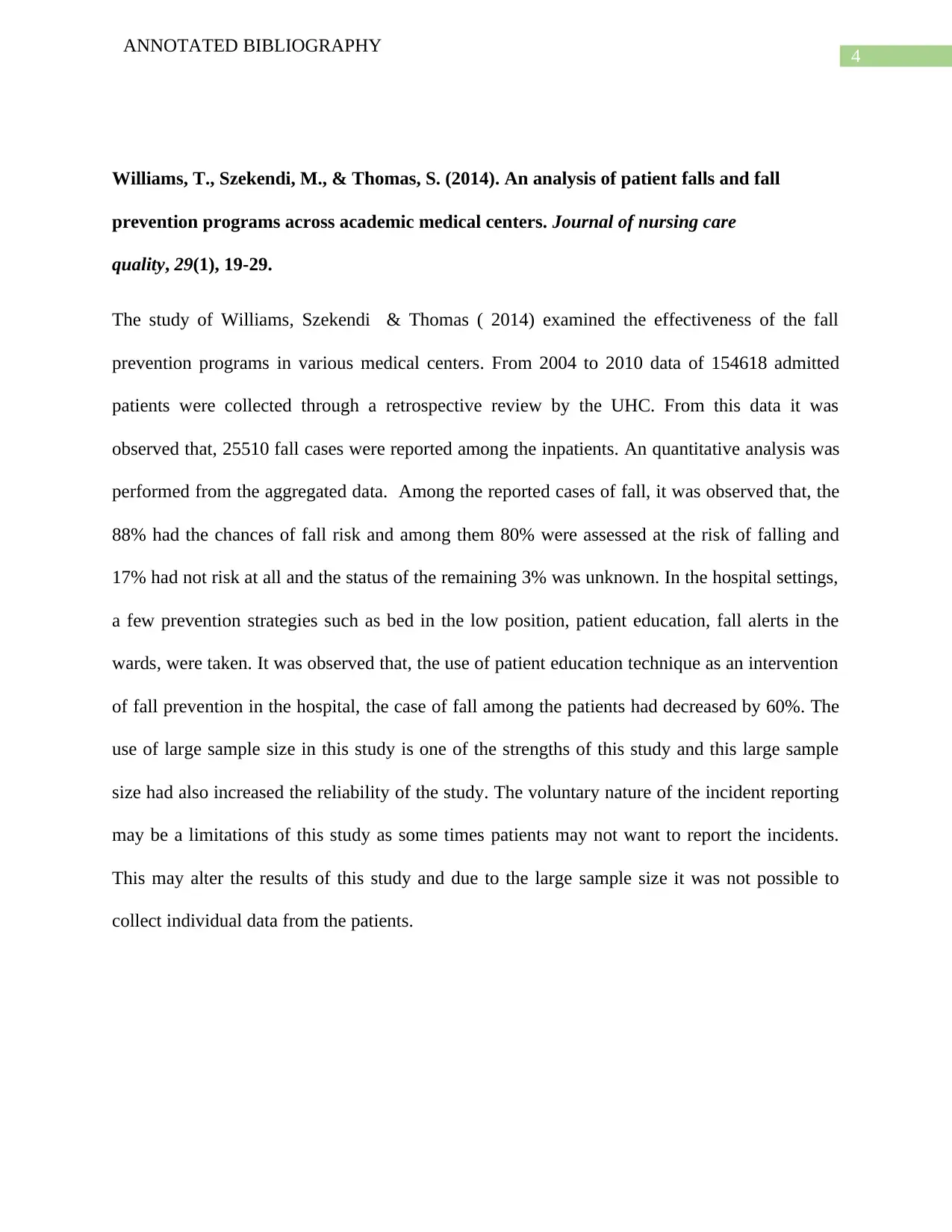
4
ANNOTATED BIBLIOGRAPHY
Williams, T., Szekendi, M., & Thomas, S. (2014). An analysis of patient falls and fall
prevention programs across academic medical centers. Journal of nursing care
quality, 29(1), 19-29.
The study of Williams, Szekendi & Thomas ( 2014) examined the effectiveness of the fall
prevention programs in various medical centers. From 2004 to 2010 data of 154618 admitted
patients were collected through a retrospective review by the UHC. From this data it was
observed that, 25510 fall cases were reported among the inpatients. An quantitative analysis was
performed from the aggregated data. Among the reported cases of fall, it was observed that, the
88% had the chances of fall risk and among them 80% were assessed at the risk of falling and
17% had not risk at all and the status of the remaining 3% was unknown. In the hospital settings,
a few prevention strategies such as bed in the low position, patient education, fall alerts in the
wards, were taken. It was observed that, the use of patient education technique as an intervention
of fall prevention in the hospital, the case of fall among the patients had decreased by 60%. The
use of large sample size in this study is one of the strengths of this study and this large sample
size had also increased the reliability of the study. The voluntary nature of the incident reporting
may be a limitations of this study as some times patients may not want to report the incidents.
This may alter the results of this study and due to the large sample size it was not possible to
collect individual data from the patients.
ANNOTATED BIBLIOGRAPHY
Williams, T., Szekendi, M., & Thomas, S. (2014). An analysis of patient falls and fall
prevention programs across academic medical centers. Journal of nursing care
quality, 29(1), 19-29.
The study of Williams, Szekendi & Thomas ( 2014) examined the effectiveness of the fall
prevention programs in various medical centers. From 2004 to 2010 data of 154618 admitted
patients were collected through a retrospective review by the UHC. From this data it was
observed that, 25510 fall cases were reported among the inpatients. An quantitative analysis was
performed from the aggregated data. Among the reported cases of fall, it was observed that, the
88% had the chances of fall risk and among them 80% were assessed at the risk of falling and
17% had not risk at all and the status of the remaining 3% was unknown. In the hospital settings,
a few prevention strategies such as bed in the low position, patient education, fall alerts in the
wards, were taken. It was observed that, the use of patient education technique as an intervention
of fall prevention in the hospital, the case of fall among the patients had decreased by 60%. The
use of large sample size in this study is one of the strengths of this study and this large sample
size had also increased the reliability of the study. The voluntary nature of the incident reporting
may be a limitations of this study as some times patients may not want to report the incidents.
This may alter the results of this study and due to the large sample size it was not possible to
collect individual data from the patients.
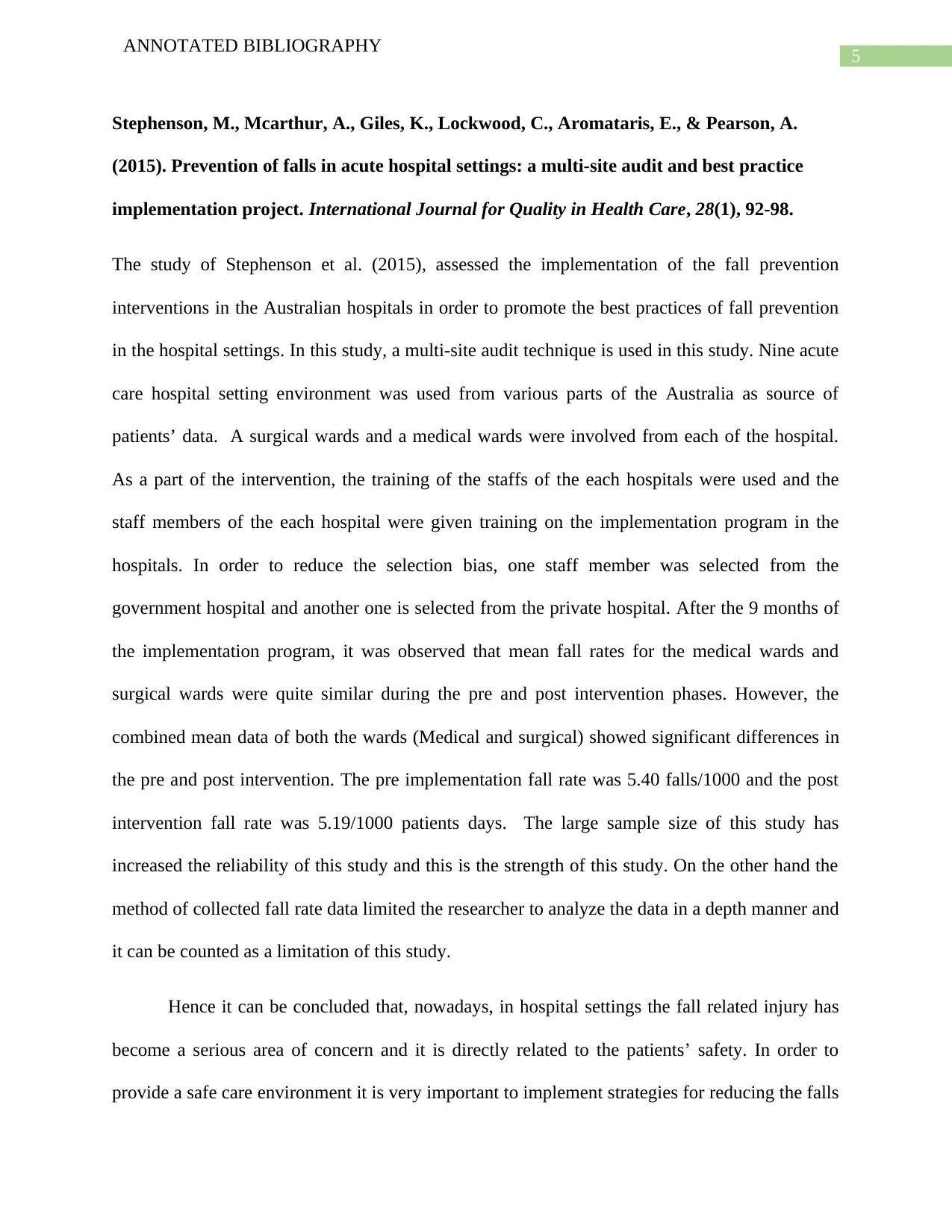
5
ANNOTATED BIBLIOGRAPHY
Stephenson, M., Mcarthur, A., Giles, K., Lockwood, C., Aromataris, E., & Pearson, A.
(2015). Prevention of falls in acute hospital settings: a multi-site audit and best practice
implementation project. International Journal for Quality in Health Care, 28(1), 92-98.
The study of Stephenson et al. (2015), assessed the implementation of the fall prevention
interventions in the Australian hospitals in order to promote the best practices of fall prevention
in the hospital settings. In this study, a multi-site audit technique is used in this study. Nine acute
care hospital setting environment was used from various parts of the Australia as source of
patients’ data. A surgical wards and a medical wards were involved from each of the hospital.
As a part of the intervention, the training of the staffs of the each hospitals were used and the
staff members of the each hospital were given training on the implementation program in the
hospitals. In order to reduce the selection bias, one staff member was selected from the
government hospital and another one is selected from the private hospital. After the 9 months of
the implementation program, it was observed that mean fall rates for the medical wards and
surgical wards were quite similar during the pre and post intervention phases. However, the
combined mean data of both the wards (Medical and surgical) showed significant differences in
the pre and post intervention. The pre implementation fall rate was 5.40 falls/1000 and the post
intervention fall rate was 5.19/1000 patients days. The large sample size of this study has
increased the reliability of this study and this is the strength of this study. On the other hand the
method of collected fall rate data limited the researcher to analyze the data in a depth manner and
it can be counted as a limitation of this study.
Hence it can be concluded that, nowadays, in hospital settings the fall related injury has
become a serious area of concern and it is directly related to the patients’ safety. In order to
provide a safe care environment it is very important to implement strategies for reducing the falls
ANNOTATED BIBLIOGRAPHY
Stephenson, M., Mcarthur, A., Giles, K., Lockwood, C., Aromataris, E., & Pearson, A.
(2015). Prevention of falls in acute hospital settings: a multi-site audit and best practice
implementation project. International Journal for Quality in Health Care, 28(1), 92-98.
The study of Stephenson et al. (2015), assessed the implementation of the fall prevention
interventions in the Australian hospitals in order to promote the best practices of fall prevention
in the hospital settings. In this study, a multi-site audit technique is used in this study. Nine acute
care hospital setting environment was used from various parts of the Australia as source of
patients’ data. A surgical wards and a medical wards were involved from each of the hospital.
As a part of the intervention, the training of the staffs of the each hospitals were used and the
staff members of the each hospital were given training on the implementation program in the
hospitals. In order to reduce the selection bias, one staff member was selected from the
government hospital and another one is selected from the private hospital. After the 9 months of
the implementation program, it was observed that mean fall rates for the medical wards and
surgical wards were quite similar during the pre and post intervention phases. However, the
combined mean data of both the wards (Medical and surgical) showed significant differences in
the pre and post intervention. The pre implementation fall rate was 5.40 falls/1000 and the post
intervention fall rate was 5.19/1000 patients days. The large sample size of this study has
increased the reliability of this study and this is the strength of this study. On the other hand the
method of collected fall rate data limited the researcher to analyze the data in a depth manner and
it can be counted as a limitation of this study.
Hence it can be concluded that, nowadays, in hospital settings the fall related injury has
become a serious area of concern and it is directly related to the patients’ safety. In order to
provide a safe care environment it is very important to implement strategies for reducing the falls
⊘ This is a preview!⊘
Do you want full access?
Subscribe today to unlock all pages.

Trusted by 1+ million students worldwide
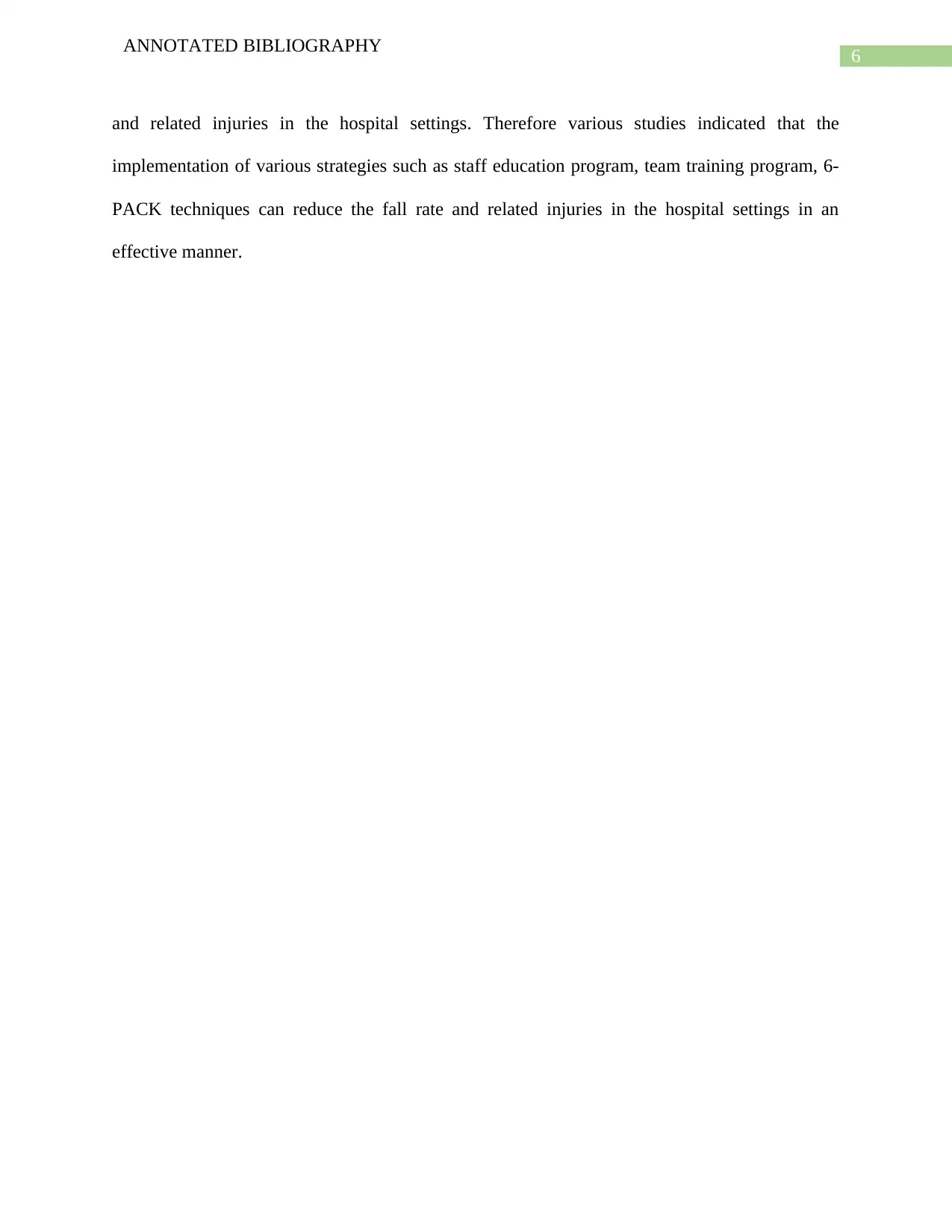
6
ANNOTATED BIBLIOGRAPHY
and related injuries in the hospital settings. Therefore various studies indicated that the
implementation of various strategies such as staff education program, team training program, 6-
PACK techniques can reduce the fall rate and related injuries in the hospital settings in an
effective manner.
ANNOTATED BIBLIOGRAPHY
and related injuries in the hospital settings. Therefore various studies indicated that the
implementation of various strategies such as staff education program, team training program, 6-
PACK techniques can reduce the fall rate and related injuries in the hospital settings in an
effective manner.
Paraphrase This Document
Need a fresh take? Get an instant paraphrase of this document with our AI Paraphraser
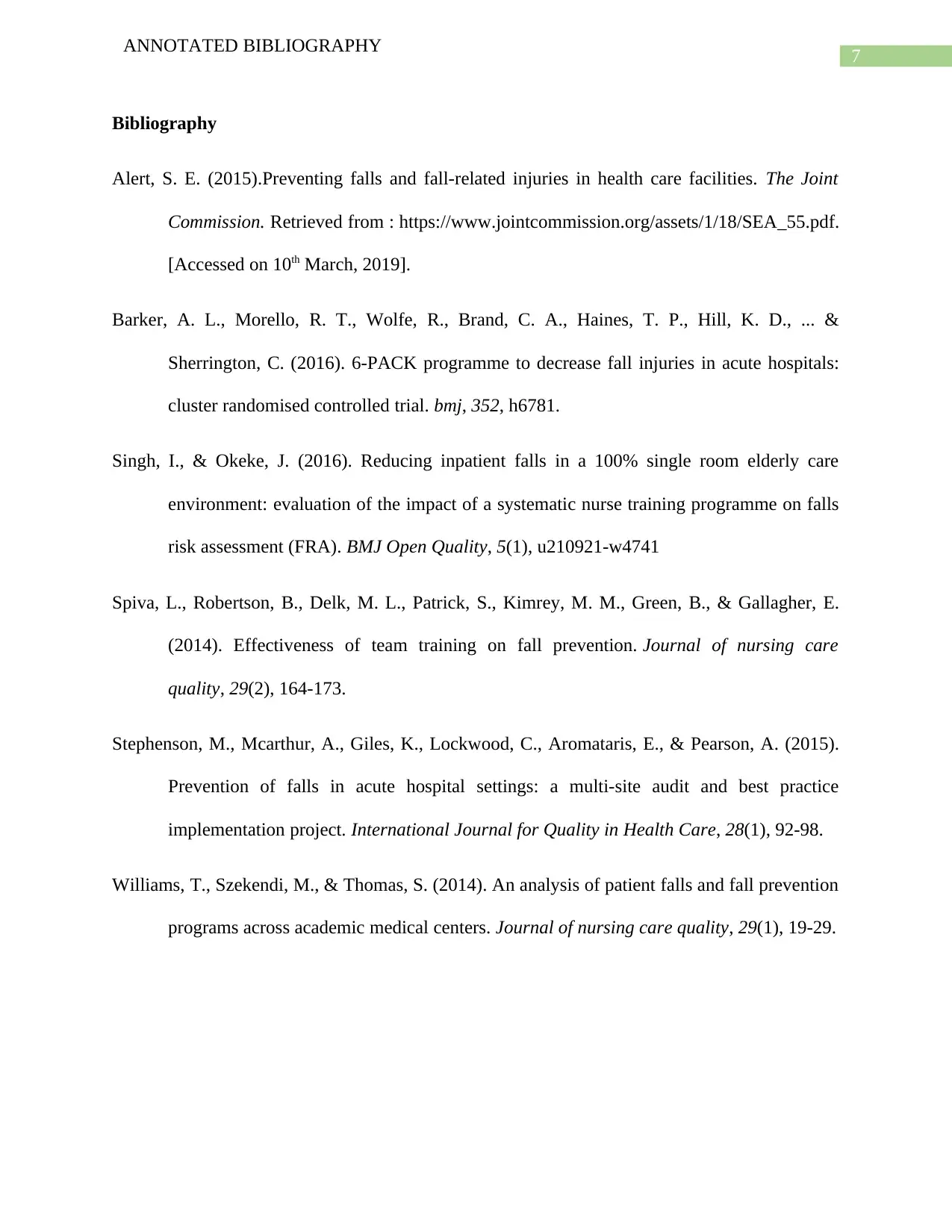
7
ANNOTATED BIBLIOGRAPHY
Bibliography
Alert, S. E. (2015).Preventing falls and fall-related injuries in health care facilities. The Joint
Commission. Retrieved from : https://www.jointcommission.org/assets/1/18/SEA_55.pdf.
[Accessed on 10th March, 2019].
Barker, A. L., Morello, R. T., Wolfe, R., Brand, C. A., Haines, T. P., Hill, K. D., ... &
Sherrington, C. (2016). 6-PACK programme to decrease fall injuries in acute hospitals:
cluster randomised controlled trial. bmj, 352, h6781.
Singh, I., & Okeke, J. (2016). Reducing inpatient falls in a 100% single room elderly care
environment: evaluation of the impact of a systematic nurse training programme on falls
risk assessment (FRA). BMJ Open Quality, 5(1), u210921-w4741
Spiva, L., Robertson, B., Delk, M. L., Patrick, S., Kimrey, M. M., Green, B., & Gallagher, E.
(2014). Effectiveness of team training on fall prevention. Journal of nursing care
quality, 29(2), 164-173.
Stephenson, M., Mcarthur, A., Giles, K., Lockwood, C., Aromataris, E., & Pearson, A. (2015).
Prevention of falls in acute hospital settings: a multi-site audit and best practice
implementation project. International Journal for Quality in Health Care, 28(1), 92-98.
Williams, T., Szekendi, M., & Thomas, S. (2014). An analysis of patient falls and fall prevention
programs across academic medical centers. Journal of nursing care quality, 29(1), 19-29.
ANNOTATED BIBLIOGRAPHY
Bibliography
Alert, S. E. (2015).Preventing falls and fall-related injuries in health care facilities. The Joint
Commission. Retrieved from : https://www.jointcommission.org/assets/1/18/SEA_55.pdf.
[Accessed on 10th March, 2019].
Barker, A. L., Morello, R. T., Wolfe, R., Brand, C. A., Haines, T. P., Hill, K. D., ... &
Sherrington, C. (2016). 6-PACK programme to decrease fall injuries in acute hospitals:
cluster randomised controlled trial. bmj, 352, h6781.
Singh, I., & Okeke, J. (2016). Reducing inpatient falls in a 100% single room elderly care
environment: evaluation of the impact of a systematic nurse training programme on falls
risk assessment (FRA). BMJ Open Quality, 5(1), u210921-w4741
Spiva, L., Robertson, B., Delk, M. L., Patrick, S., Kimrey, M. M., Green, B., & Gallagher, E.
(2014). Effectiveness of team training on fall prevention. Journal of nursing care
quality, 29(2), 164-173.
Stephenson, M., Mcarthur, A., Giles, K., Lockwood, C., Aromataris, E., & Pearson, A. (2015).
Prevention of falls in acute hospital settings: a multi-site audit and best practice
implementation project. International Journal for Quality in Health Care, 28(1), 92-98.
Williams, T., Szekendi, M., & Thomas, S. (2014). An analysis of patient falls and fall prevention
programs across academic medical centers. Journal of nursing care quality, 29(1), 19-29.

8
ANNOTATED BIBLIOGRAPHY
ANNOTATED BIBLIOGRAPHY
⊘ This is a preview!⊘
Do you want full access?
Subscribe today to unlock all pages.

Trusted by 1+ million students worldwide
1 out of 9
Related Documents
Your All-in-One AI-Powered Toolkit for Academic Success.
+13062052269
info@desklib.com
Available 24*7 on WhatsApp / Email
![[object Object]](/_next/static/media/star-bottom.7253800d.svg)
Unlock your academic potential
Copyright © 2020–2025 A2Z Services. All Rights Reserved. Developed and managed by ZUCOL.





